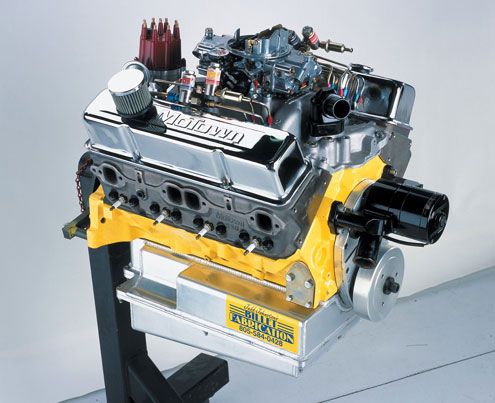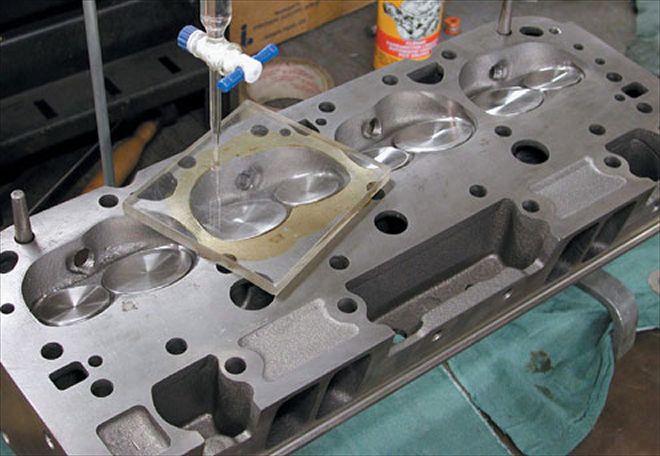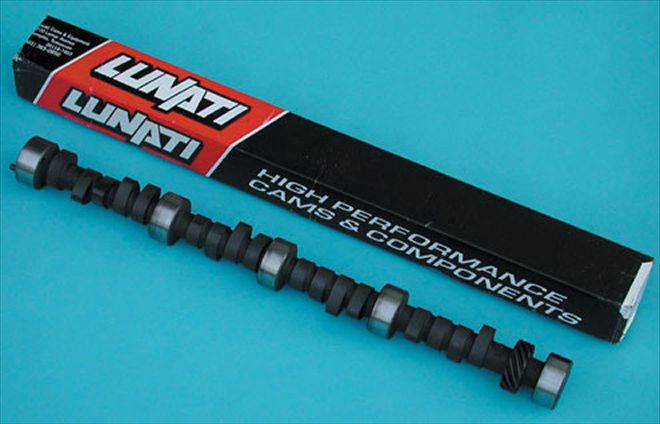
Last time you saw the Anvil, it was all dressed in EFI, respectable like. Now it's returning to glorious low-tech with a classic case of cam-and-intake shape-shifting of the power curve.
Back in the Nov. '02 issue, we set up our Anvil small-block with Holley's Wild Street combination of cam, heads, and intake and made 460 hp. A few called us wimps, so here's the answer: World Products' Motown 220 heads, a huge Lunati solid-lifter cam, Holley's Strip Dominator single-plane intake, and an 830-cfm Holley double-pumper (not shown in the photo above), delivering 528 hp at 6,700 and 458 lb-ft at 5,100.
 Tim Martindale at Dougan's Engine helped us check the bare Motown 220 castings and load them with Milodon MegaFlow Competition 2.08/1.60 valves. The chambers were 64 cc, exactly as advertised, giving us 10.02:1 compression. All the World Products machining specs were right on the money, so we were able to just slam the valves in and go. The springs were set at 150 pounds on the seat and 330 pounds open pressure, and we had no valve-float issues clear to 7,000 rpm. At press time, the bare Motown 220 iron heads were on sale at Summit for $553 a pair, or $939.90 for an assembled pair with chrome valve covers.
Tim Martindale at Dougan's Engine helped us check the bare Motown 220 castings and load them with Milodon MegaFlow Competition 2.08/1.60 valves. The chambers were 64 cc, exactly as advertised, giving us 10.02:1 compression. All the World Products machining specs were right on the money, so we were able to just slam the valves in and go. The springs were set at 150 pounds on the seat and 330 pounds open pressure, and we had no valve-float issues clear to 7,000 rpm. At press time, the bare Motown 220 iron heads were on sale at Summit for $553 a pair, or $939.90 for an assembled pair with chrome valve covers.

It's just like a car mag to preach big power numbers as the sole solution to all your life's woes, but there's good news and bad news here. Good: This thing would run 11s in the right car, and it would be easy to cheaply duplicate on the 350 small-block of your choice thanks to iron heads and a miserly flat-tappet cam. No rocket science. Bad: You'll need a light car, a 4,500-stall converter, and some steep cogs to make this engine anything less than a dog.
It's not a bad combo--you just need to know what you're in for if you build anything similar: Check out the Anvil Power Comparo sidebar, and you'll see that the smaller-cammed Wild Street setup (Combo 1) made significantly more horsepower and torque at every rpm point below 4,700 as compared to the bigger cam, heads, and intake (Combo 2). We've often said that bigger cams don't really make less torque, they just peak at a higher rpm and, in many cases, actually make more torque throughout the curve than smaller cams. Untrue in this case, where we threw in an extra 21/27 degrees of camshaft duration at 0.050 tappet lift. Perhaps the problem was the intake runner size. World Products doesn't recommend these heads for engines below 383 ci, but we thought we could pull it off thanks to the rpm range with the Lunati 256/268-at-0.050 solid cam. As it turned out, the runner size probably contributed to a poor bottom half of the torque curve on our low-compression 359-incher. Our bad.
See the sidebars for the details. Then come back next month, when we cave in to the full-race nature of the newly cammed beast and make truly huge power with no apologies. Just a hole in the hood, if you catch our drift.